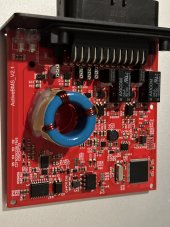The market is flooded with nasty capacitor balancers, because they are very cheap to manufacture.
They don't work very well, and are potentially unreliable, especially when cheap aluminium electrolytics are used.
The manufacturers of these useless horrors are all in competition with each other, and whoever can produce the cheapest balancer, and makes the biggest claims for it, sells the most balancers. That is what its all about....
That is what the market wants (cheap) and that is what we get.
It does not need to be that way, but something that works a lot better and is potentially more reliable is entirely possible to design and build, but nobody wants to buy something that is expensive, when something dirt cheap is available.
An even bigger problem are the outright deceptions made by the advertising people.
Claims of X amps balancing current are worthless without also defining the voltage difference required to achieve that current.
Its a fact that if you reverse engineer these things, the claims made for them are ridiculous using the capacitor values they actually use in their balancers.
If you have reasonably large cells, and you are serious the only workable system that can transfer enough energy at low enough voltage differentials to be useful, must have a very low impedance between cells, and be able to transfer energy from any cell to any other cell, not just the one immediately next to it. Ultra low impedance is the key.
Now suppose you have one ohm of resistance, and you parallel two cells that have a one volt difference. You might see one miserable amp flowing.
Not five amps, or ten amps. And one volt difference is a hell of a lot !!!
Suppose its only fifty millivolts difference, you might see only 50mA of balance current with one ohm of series resistance in your balancer, and that is a more realistic voltage difference.
If you expect one amp of balance current at 50mV differential (not unrealistic) simple ohms law will tell you that the total resistance needs to be 50 milliohms, or less.
That is not easy to do when you start looking at the combined ohmic resistance of the mosfets, pcb tracks, and the skinny balance wires to each individual cell usually provided.
These balancers always pulse, the balance current is never pure dc. So you also need to take into account the duty cycle as well.
So for a realistic one amp at 50mV voltage differential, the conduction impedance might need to be more like 10 milliohms.
Its entirely possible to build something that can do that, but it would have to be an inductive balancer, not a capacitor balancer, and use a large and relatively expensive single toroidal transformer, heavy windings and heavy wiring to each cell, and very low rds on resistance mosfets, and large beefy pcb tracks. Basically a very large, klunky, and expensive unit to build, that nobody would be prepared to pay for.
And that is how it is.....
End of rant.



